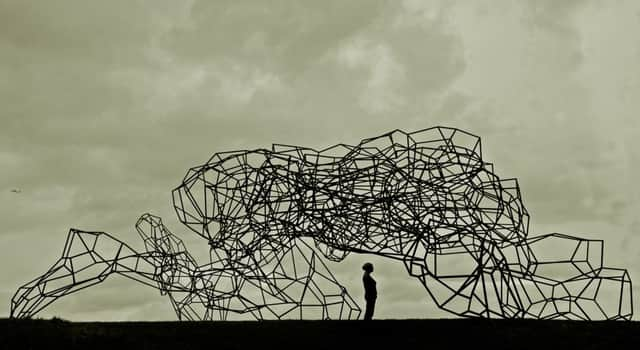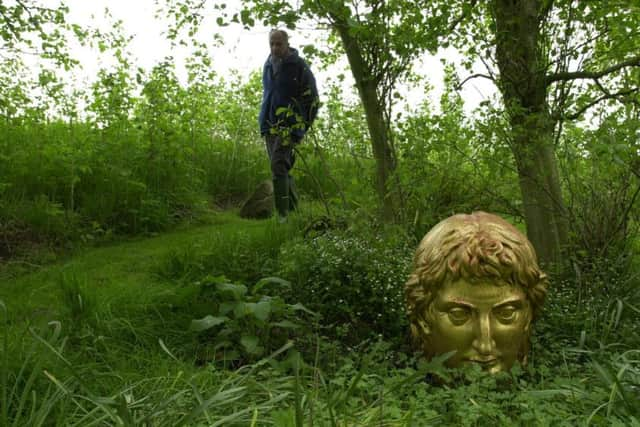The best places to see outdoor art in Scotland


Everyone knows The Kelpies. So much so, the two proudly poised horse heads will no doubt become as much of a landmark as Edinburgh Castle or the Glenfinnan viaduct. Thanks to his equine sculpture, Andy Scott has sealed his reputation as a successful and prolific Scottish artist. Throughout the Central Belt, traces of his tributes to man, woman, beast and machine can be readily identified. But across Scotland are numerous pockets of public art found in the most unexpected places, from housing schemes to hilltops and dark woodlands. By placing these works outside of traditional venues, artists give their work a new context, and allow the public to engage with it on a much grander scale.
Little Sparta, Dunsyre, South Lanarkshire
This sleepy secret art garden only allows 5,000 visitors a year, such is the determination to preserve the Little Sparta experience. Little Sparta is recognised as the greatest work of the late Ian Hamilton Finlay, who forged peaceful horticultural elements with individual sculptures made from stone, wood and metal to create his most famous work. There are more than 275 art works to stumble across in this creative idyll, with Finlay determined to address the big issues in the vein of a philosopher’s garden while also celebrating the cosy and small. The garden was taken over by a trust following the artist’s death in 2006, and trustees are now opposing a proposal to expand Pentland Hills Regional Part, which could catch Little Sparta within its enlarged boundary.


Striding Arches, Cairnhead, Dumfries and Galloway
Advertisement
Hide AdSculptor Andy Goldsworthy loves an arch. He has built them all over the world after first becoming obsessed with the structures more than 20 years ago. It was the “magic” of stone holdings itself together – and the technical aspects of the tension - that really got him thinking. There are arches in Montreal and New Zealand but many in Britain too, each one illustrating some sort of connection between two points. In Dumfries and Galloway, where Goldsworthy lives, the sculptor selected the isolated hilltop of Carinhead to display a series of arches.
Three self-supporting sandstone structures are now placed on summits around the glen – on Bail Hill, Benbrack and Colt Hill. Goldsworthy sees the arches as walking the hills “alongside the people” with the project enjoying a huge public following in the area. From a window of the Byre – a renovated farm building - pops another Goldsworthy arch, poised as though taking its first step into the landscape. It also doubles as a handy shelter from the elements.
Jupiter Artland, Bonnington West, Lothian
Buy a Jacobean mansion, buy the field next door, then set to work creating a creative playground stuffed full of sculpture. That is what Nicola and Robert Wilson did – and the end result was Jupiter Artland in West Lothian. As you forage through the visual fairground, visitors may well stumble across works by sculptors including Mark Quinn, Anish Kapoor and Anthony Gormley. It really is pretty special – and just 10 miles west of Edinburgh. Jupiter Artland was also heavily inspired by Little Sparta and many pieces of Hamilton Finlay’s work are on show here. Postmodern architect Charles Jencks sets the scene for Jupiter Artland with his commission Life Mounds, eight swirling vivid green grassy mounds that were reportedly inspired by molecular biology and outer space. Jupiter Artland, which also runs huge education programme, is open for the summer only.
Glenrothes, Fife
It’s got giant mushrooms, it’s got concrete hippos, and it got people in a post-war New Town thinking about art. Such was Glenrothes’ influence in forging an appreciation of public art, Historic Scotland has listed several artworks to protect them for generations to come. Glenrothes’ place on the art map was sealed when town planners, faced with the mission of creating an appealing new town for around 34,000 folk, appointed an artist. It was a very modern move. David Harding, just back from Africa, landed the job and moved into a council flat in Glenrothes with his family. His mission was to bring people to art and vice versa. In 2011 Historic Scotland awarding listed building status to a number of artworks scattered throughout the town and acknowledged Glenrothes’ significant role in using art to create a sense of place. Listed pieces include Ex Terra, by sculptor Benne Schotz (1891-1984), the former head of sculpture at Glasgow School of Art and past Queen’s Sculptor in Scotland. The hippos, which are found bathing and feeding across the town, were created by artist Stanley Bonnar, who was fresh out of art school in Dundee when he made the beasts. He may have been rebellious then, but the hippos are now just happily part of the fabric of this former mining town.
River Clyde, Glasgow
The banks of the Clyde have been transformed by around a dozen significant works of art that have started a fresh conversation about the historic 30-mile waterway. Art has been used to redefine and re-energise the communities around the once powerhouse Clyde as part of a mass regeneration project. Toby Paterson’s Poised Array was the most expensive piece of public art ever nailed down in Glasgow when it went on show 2007, at a cost of £350,000. Sitting outside BBC’s headquarters at Pacific Quay, it is a nod to the manufacturing history of the site. Some describe it as a clutch of colourful children’s windmills. The artists says it is based on portions of Ordanance Survey maps. Other pieces include Jephson Robb’s Change at Clyde Gate, a five-metre high locked chain by the National Golden Jubilee Hospital at Clydebank. Andy Scott is no stranger to the banks, with Rise, installed at Meadowside Square, using chains, propeller blades, welding and casting to retell the past while forging the future.